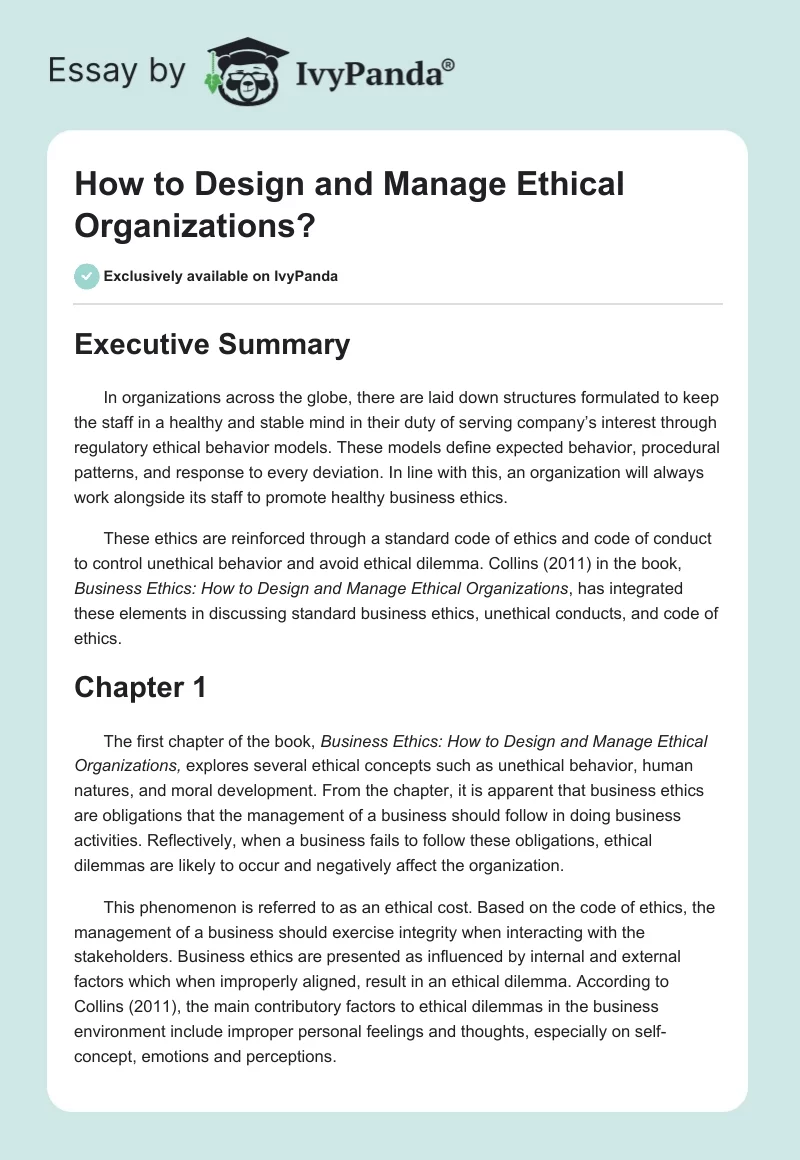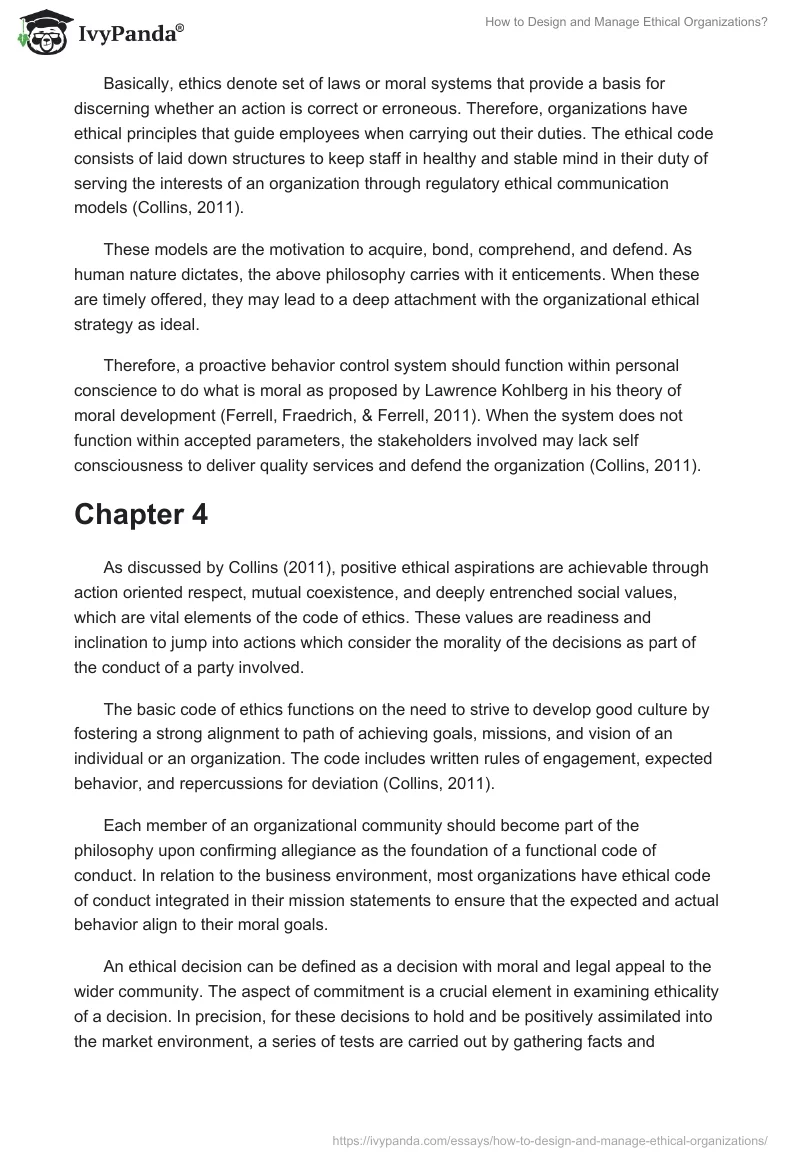Executive Summary
In organizations across the globe, there are laid down structures formulated to keep the staff in a healthy and stable mind in their duty of serving company’s interest through regulatory ethical behavior models. These models define expected behavior, procedural patterns, and response to every deviation. In line with this, an organization will always work alongside its staff to promote healthy business ethics.
These ethics are reinforced through a standard code of ethics and code of conduct to control unethical behavior and avoid ethical dilemma. Collins (2011) in the book, Business Ethics: How to Design and Manage Ethical Organizations, has integrated these elements in discussing standard business ethics, unethical conducts, and code of ethics.
Chapter 1
The first chapter of the book, Business Ethics: How to Design and Manage Ethical Organizations, explores several ethical concepts such as unethical behavior, human natures, and moral development. From the chapter, it is apparent that business ethics are obligations that the management of a business should follow in doing business activities. Reflectively, when a business fails to follow these obligations, ethical dilemmas are likely to occur and negatively affect the organization.
This phenomenon is referred to as an ethical cost. Based on the code of ethics, the management of a business should exercise integrity when interacting with the stakeholders. Business ethics are presented as influenced by internal and external factors which when improperly aligned, result in an ethical dilemma. According to Collins (2011), the main contributory factors to ethical dilemmas in the business environment include improper personal feelings and thoughts, especially on self-concept, emotions and perceptions.
Basically, ethics denote set of laws or moral systems that provide a basis for discerning whether an action is correct or erroneous. Therefore, organizations have ethical principles that guide employees when carrying out their duties. The ethical code consists of laid down structures to keep staff in healthy and stable mind in their duty of serving the interests of an organization through regulatory ethical communication models (Collins, 2011).
These models are the motivation to acquire, bond, comprehend, and defend. As human nature dictates, the above philosophy carries with it enticements. When these are timely offered, they may lead to a deep attachment with the organizational ethical strategy as ideal.
Therefore, a proactive behavior control system should function within personal conscience to do what is moral as proposed by Lawrence Kohlberg in his theory of moral development (Ferrell, Fraedrich, & Ferrell, 2011). When the system does not function within accepted parameters, the stakeholders involved may lack self consciousness to deliver quality services and defend the organization (Collins, 2011).
Chapter 4
As discussed by Collins (2011), positive ethical aspirations are achievable through action oriented respect, mutual coexistence, and deeply entrenched social values, which are vital elements of the code of ethics. These values are readiness and inclination to jump into actions which consider the morality of the decisions as part of the conduct of a party involved.
The basic code of ethics functions on the need to strive to develop good culture by fostering a strong alignment to path of achieving goals, missions, and vision of an individual or an organization. The code includes written rules of engagement, expected behavior, and repercussions for deviation (Collins, 2011).
Each member of an organizational community should become part of the philosophy upon confirming allegiance as the foundation of a functional code of conduct. In relation to the business environment, most organizations have ethical code of conduct integrated in their mission statements to ensure that the expected and actual behavior align to their moral goals.
An ethical decision can be defined as a decision with moral and legal appeal to the wider community. The aspect of commitment is a crucial element in examining ethicality of a decision. In precision, for these decisions to hold and be positively assimilated into the market environment, a series of tests are carried out by gathering facts and incorporating them in defined issues surrounding ethics to test the consciousness in application (Collins, 2011).
The aspect of competency is critical in separating the premises from assumptions in making ethical decisions. The dual pillar approach to ethical leadership comprises of a combination of moral being and moral management skills. The combination of the two aspects in a strategic organizational plan is critical in building ethical leadership reputation since executive responsibility functions on moral codes that promote proactive leadership (Francke, 2012).
The process of decision making is dependent on the ethical conduct and code since they provide assumptions, integration of options, and ethical control. Decision environment often experience dynamics and swings which create short and long term effect on chances of survival for two alternatives to solve a problem.
When faced with a decision dilemma that requires critical assessments, morally upright organizations resort to analytical tools that ensure competitive positioning advantage. The competitive advantage position is meant to minimize the costs of different ethical dilemmas (Ferrell, Fraedrich, & Ferrell, 2011). Each option is assigned to a quadrant with predetermined response strategies and ‘follow-ups’ upon implementation.
References
Collins, D. (2011). Business Ethics: How to Design and Manage Ethical Organizations. New York, NY: Wiley and Sons.
Ferrell, O., Fraedrich, J., & Ferrell, L. (2011). Business Ethics: Ethical Decision Making and Cases. Alabama, Al: Cengage Learning.
Francke, A. (2012). Bringing ethics back to business through effective management. Web.


